Long-time Esteemed Readers - and fans of gluttony gourmandise in general - will remember the infamous Aubrey/Maturin Dinner Houston Steve and I put on last year about this time.
Or its sequel in mid-March, in which lighter Gunroom Fare (if you can consider a Steak, Kidney, and Oyster Pie “light”) was substituted for the massive meats of the Captain’s Table.
Whether you recall these Major Events or not, however, Houston Steve and I share the belief that “nothing exceeds like excess” - and so we decided to put on Yet Another Big Feed this past Saturday evening in celebration of the collected novels of Patrick O’Brian...and (more or less) in the style of the British Royal Navy, circa 1800.
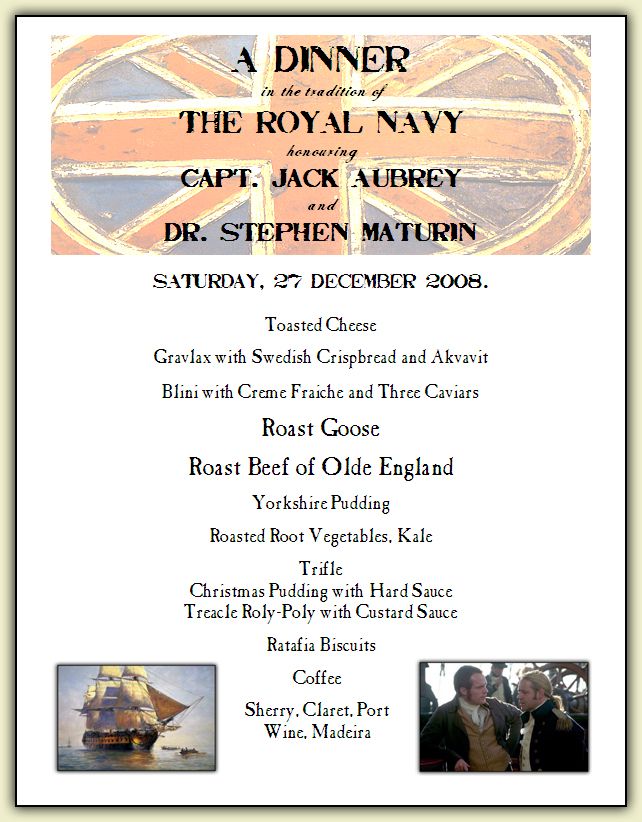
The menu. Click to embiggen.
The menu once again featured last year’s Roast Beef of Olde England, along with a sumptuous Roast Goose...but this time we imagined a Baltic Sea jaunt for the good Captain, offering appetizers of gravlax and Swedish crispbread (with akvavit libations) and blini with crème fraîche and caviar in lieu of last year’s Strasburg Pie. Toasted Cheese, too. You cannot begin to envision a meal involving the good Captain Jack Aubrey without Toasted Cheese. (“Killick! Killick, there!” “Which I’m bringing the toasted cheese, ain’t I?”)
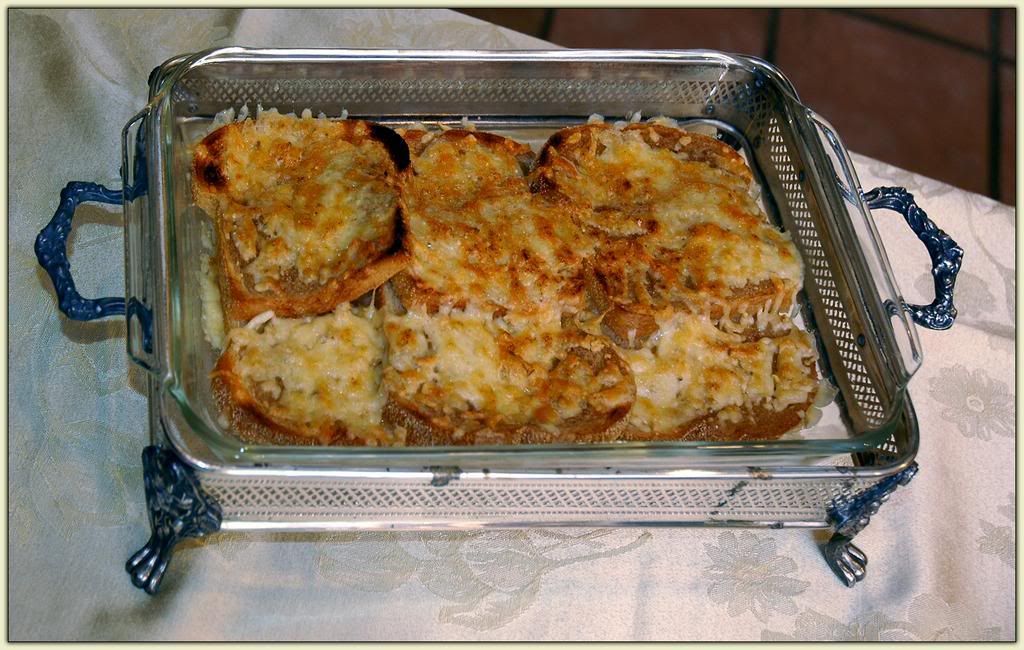
Toasted cheese.
This year, we were joined by our friends Barry and Malka, as well as Stefan P. and Denny, the Grouchy Old Cripple hizzownself. Stefan and Denny brought out a brace of fine old bottles from their respective cellars, and Barry contributed a bottle of Jackson-Trigg icewine...all of which meant that we had plenty with which to wash down the immense quantities of food.
Before we even sat down to the Main Event, we attacked the bottles Stefan had brought, all venerable old wines. The oldest, a 1970 Cos d’Estournel Saint-Estèphe, is from a harvest that took place during my freshman year in college, and it has held up at least as well as I have since then. You can’t make out the price sticker in the photograph, but I can tell you that Stefan paid less than $9 for that bottle. If you can find a 1970 today, you’ll pay about $150 for it...and the 2005’s are going for north of $240.
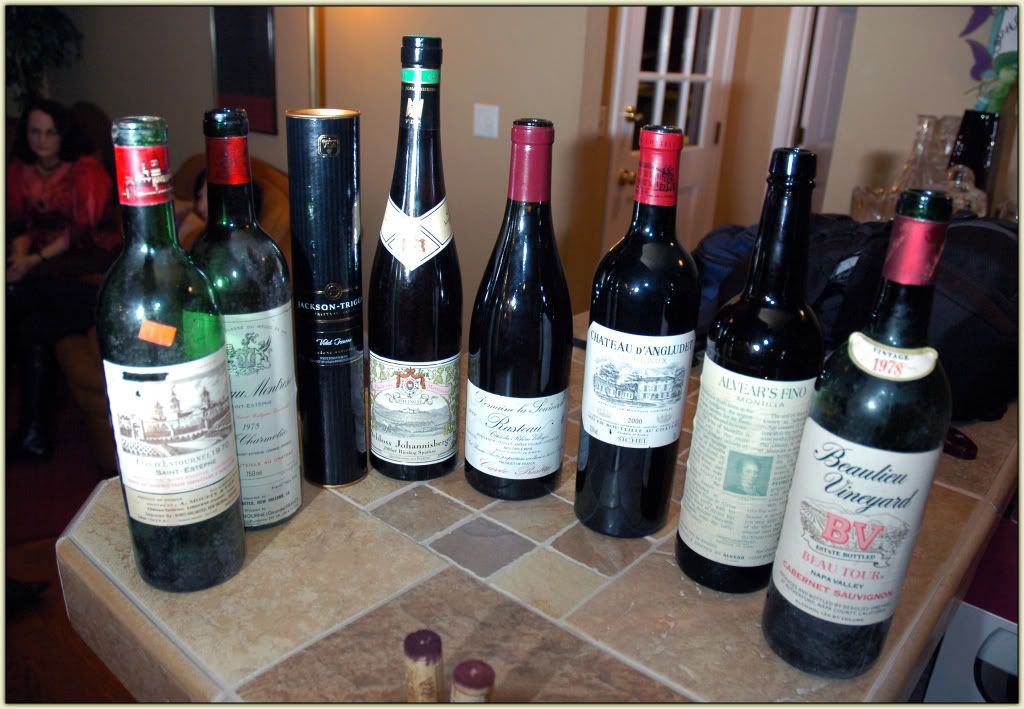
The wines (L to R): Château Cos d’Estournel Saint-Estèphe 1970, Château Montrose Saint-Estèphe 1978, Jackson-Trigg Vidal Icewine 2006, Schloss Johannisberger Riesling Spätlese 2005, Domaine La Soumade Rasteau Côtes du Rhône Villages 2000, Château d’Angludet Margaux 2000, Alvear’s Fino Sherry, Beaulieu Vineyard “Beau Tour” Napa Valley Cabernet Sauvignon 1978.
Steve and I divided the entrées between us, with him preparing the huge Roast of Beef - a four-bone prime rib with a porcini mushroom crust - and with me cooking the goose. One of the side benefits of roasting a goose (aside from coating the interior of the oven with a thick layer of grease) is the byproduct: a full quart or more of rich, unctuous goose schmaltz. Mmmmm, yum!
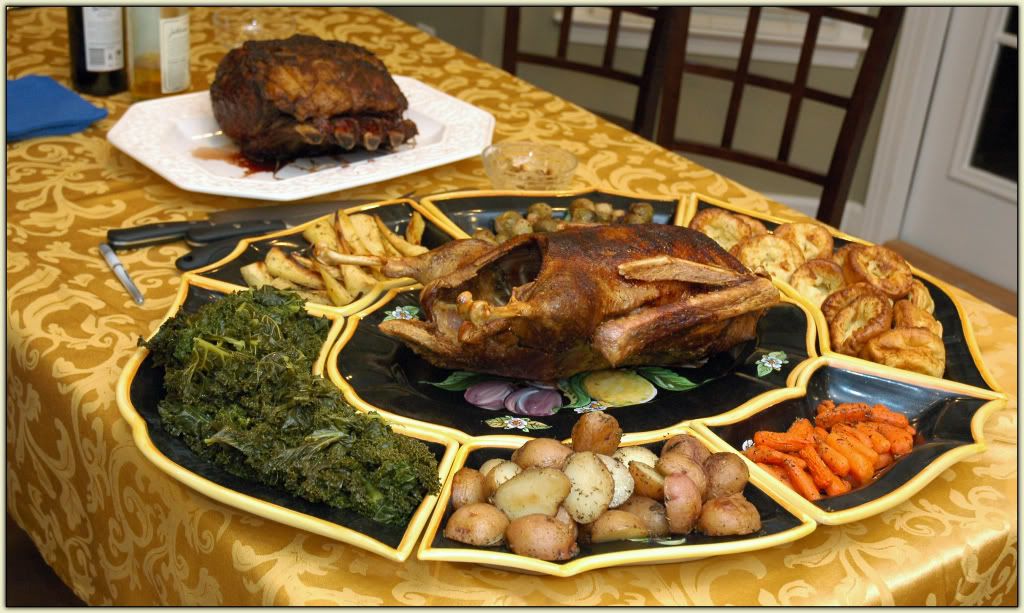
The Main Event. Roast Beef of Olde England in the background; roast goose in the center. Surrounding the goose (clockwise from left) we have steamed kale, roasted parsnips and Brussels sprouts, Yorkshire puddings, carrots, and new potatoes.
One of the reasons Houston Steve so enjoys our Aubrey/Maturin festivities, I suspect, is that it allows him free play for his English-born Food Imagination, especially in the area of Puddings. For Pudding, to the English, is not some chocolaty crap that comes from a box labeled Jell-O™ or My-T-Fine™. In most cases, pudding is dessert; and dessert is Pudding, by definition. But puddings are simply concoctions of starch (usually flour) and some kind of grease, usually beef suet. They may be savory or sweet.
On the savory side, we had individual Yorkshire puddings baked in muffin tins, flavored with the molten drippings from the humongous roast. Yorkshire pudding is no dessert; it is, however, the finest Gravy Conveyance Device known to modern man.
By way of dessert, Steve made two (count ’em) traditional puddings: one, a Christmas pudding from his grandmother’s recipe; the other, a Treacle Roly-Poly. The former is steamed whilst the latter, a cylindrical jelly-roll-style affair, is rolled up in a towel and boiled for several hours.
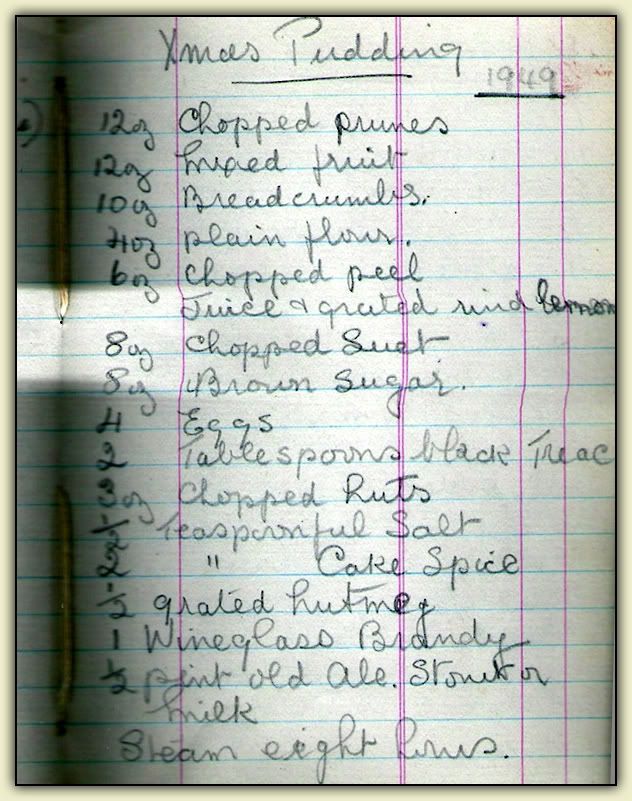
Grandma’s Christmas Pudding, a 1949-vintage recipe. Click to embiggen.
The Christmas pudding was superb, in my non-humble opinion - even better than last year’s version. The Roly-Poly, meanwhile, made Steve’s eyes light up with memories of childhood meals in London. A real, old-school British pudding, it was.
[You want to make your own Treacle Roly-Poly? Instructions are below the fold...along with more photos.]
Coffee, ratafia biscuits (AKA amaretti), some excellent dessert wines (including a marvelous Jackson-Trigg icewine), Cognac, and a spot of Poire William, and it was time to make sail for our Home Port, bellies fully distended.
Leftovers? There were leftovers aplenty. That’s what we had for dinner the next night. Gaaaah.
Or its sequel in mid-March, in which lighter Gunroom Fare (if you can consider a Steak, Kidney, and Oyster Pie “light”) was substituted for the massive meats of the Captain’s Table.
Whether you recall these Major Events or not, however, Houston Steve and I share the belief that “nothing exceeds like excess” - and so we decided to put on Yet Another Big Feed this past Saturday evening in celebration of the collected novels of Patrick O’Brian...and (more or less) in the style of the British Royal Navy, circa 1800.

The menu. Click to embiggen.
The menu once again featured last year’s Roast Beef of Olde England, along with a sumptuous Roast Goose...but this time we imagined a Baltic Sea jaunt for the good Captain, offering appetizers of gravlax and Swedish crispbread (with akvavit libations) and blini with crème fraîche and caviar in lieu of last year’s Strasburg Pie. Toasted Cheese, too. You cannot begin to envision a meal involving the good Captain Jack Aubrey without Toasted Cheese. (“Killick! Killick, there!” “Which I’m bringing the toasted cheese, ain’t I?”)

Toasted cheese.
This year, we were joined by our friends Barry and Malka, as well as Stefan P. and Denny, the Grouchy Old Cripple hizzownself. Stefan and Denny brought out a brace of fine old bottles from their respective cellars, and Barry contributed a bottle of Jackson-Trigg icewine...all of which meant that we had plenty with which to wash down the immense quantities of food.
Before we even sat down to the Main Event, we attacked the bottles Stefan had brought, all venerable old wines. The oldest, a 1970 Cos d’Estournel Saint-Estèphe, is from a harvest that took place during my freshman year in college, and it has held up at least as well as I have since then. You can’t make out the price sticker in the photograph, but I can tell you that Stefan paid less than $9 for that bottle. If you can find a 1970 today, you’ll pay about $150 for it...and the 2005’s are going for north of $240.

The wines (L to R): Château Cos d’Estournel Saint-Estèphe 1970, Château Montrose Saint-Estèphe 1978, Jackson-Trigg Vidal Icewine 2006, Schloss Johannisberger Riesling Spätlese 2005, Domaine La Soumade Rasteau Côtes du Rhône Villages 2000, Château d’Angludet Margaux 2000, Alvear’s Fino Sherry, Beaulieu Vineyard “Beau Tour” Napa Valley Cabernet Sauvignon 1978.
Steve and I divided the entrées between us, with him preparing the huge Roast of Beef - a four-bone prime rib with a porcini mushroom crust - and with me cooking the goose. One of the side benefits of roasting a goose (aside from coating the interior of the oven with a thick layer of grease) is the byproduct: a full quart or more of rich, unctuous goose schmaltz. Mmmmm, yum!

The Main Event. Roast Beef of Olde England in the background; roast goose in the center. Surrounding the goose (clockwise from left) we have steamed kale, roasted parsnips and Brussels sprouts, Yorkshire puddings, carrots, and new potatoes.
One of the reasons Houston Steve so enjoys our Aubrey/Maturin festivities, I suspect, is that it allows him free play for his English-born Food Imagination, especially in the area of Puddings. For Pudding, to the English, is not some chocolaty crap that comes from a box labeled Jell-O™ or My-T-Fine™. In most cases, pudding is dessert; and dessert is Pudding, by definition. But puddings are simply concoctions of starch (usually flour) and some kind of grease, usually beef suet. They may be savory or sweet.
On the savory side, we had individual Yorkshire puddings baked in muffin tins, flavored with the molten drippings from the humongous roast. Yorkshire pudding is no dessert; it is, however, the finest Gravy Conveyance Device known to modern man.
By way of dessert, Steve made two (count ’em) traditional puddings: one, a Christmas pudding from his grandmother’s recipe; the other, a Treacle Roly-Poly. The former is steamed whilst the latter, a cylindrical jelly-roll-style affair, is rolled up in a towel and boiled for several hours.

Grandma’s Christmas Pudding, a 1949-vintage recipe. Click to embiggen.
The Christmas pudding was superb, in my non-humble opinion - even better than last year’s version. The Roly-Poly, meanwhile, made Steve’s eyes light up with memories of childhood meals in London. A real, old-school British pudding, it was.
[You want to make your own Treacle Roly-Poly? Instructions are below the fold...along with more photos.]
Coffee, ratafia biscuits (AKA amaretti), some excellent dessert wines (including a marvelous Jackson-Trigg icewine), Cognac, and a spot of Poire William, and it was time to make sail for our Home Port, bellies fully distended.
Leftovers? There were leftovers aplenty. That’s what we had for dinner the next night. Gaaaah.
Some more photos:

Denny, the Not-So-Grouchy Cripple.

Stefan tastes a wine that was laid down during the Nixon administration.
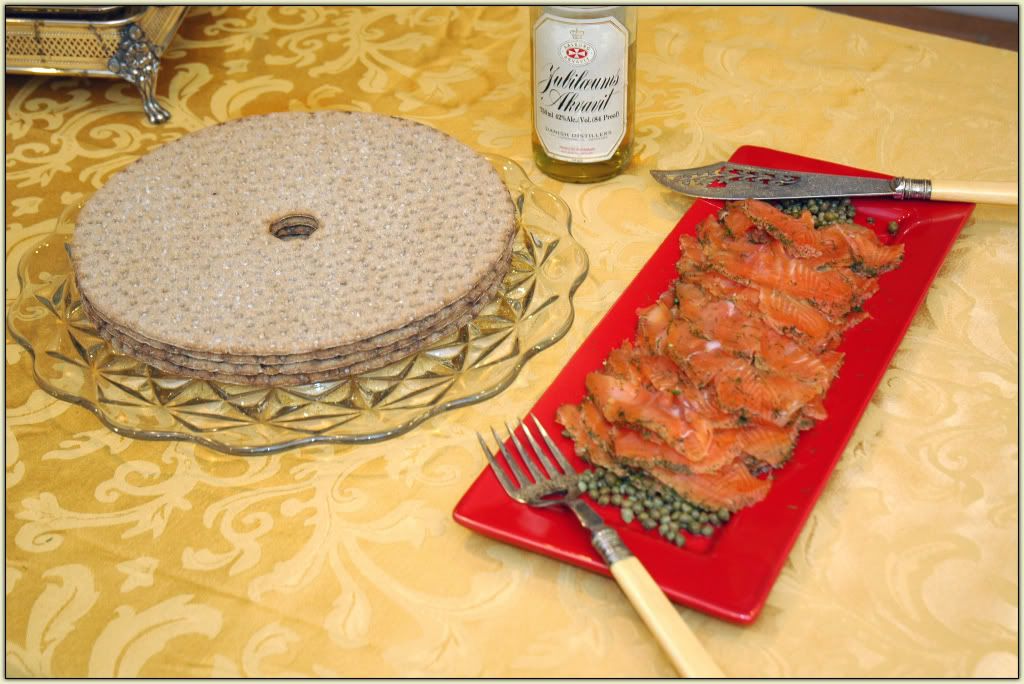
Gravlax with Swedish knakkebröd (crispbread) and akvavit chasers. The silver implements belonged to Houston Steve’s great-great-grandmother.
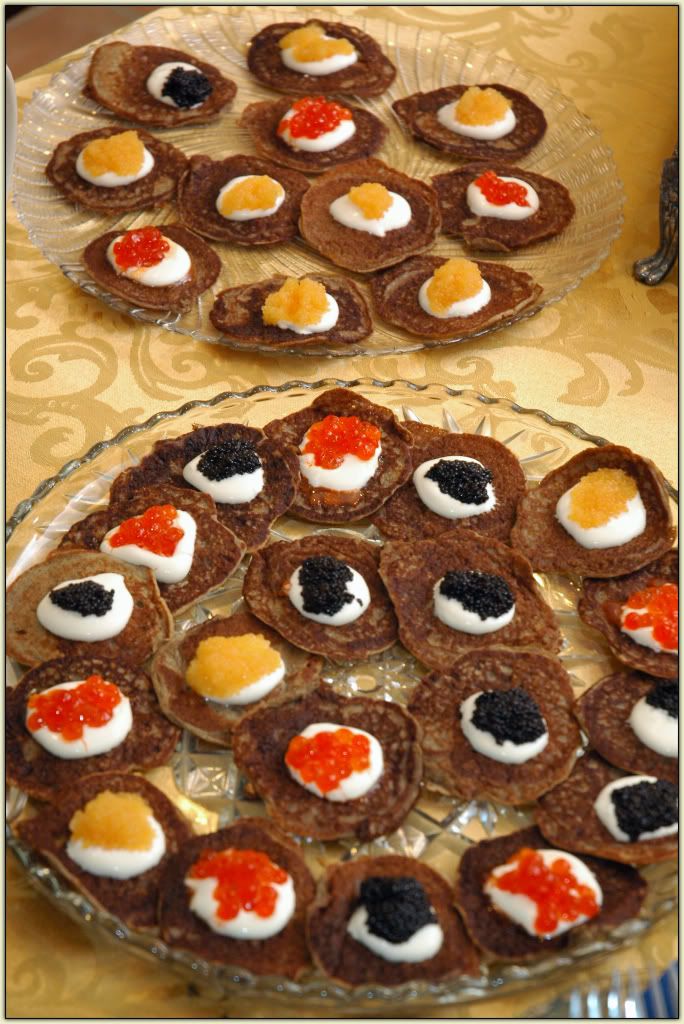
Blini - yeast-raised buckwheat pancakes - with crême fraîche and three kinds of caviar (salmon, whitefish, and bowfin).
For those who crave a taste of a dessert so authentically British, even most Brits are afraid of it, try this:
Treacle Roly-Poly
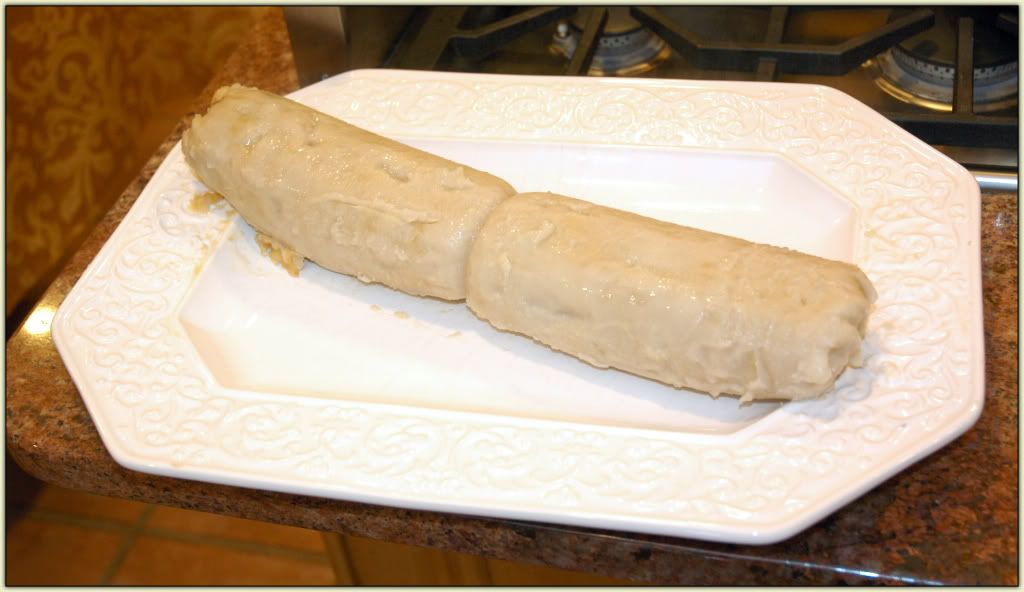
Treacle Roly-Poly, ready to slice and serve with lashings of Custard Sauce.
Dough:
½ pound suet, finely grated
4 cups flour
¼ cup sugar
½ tsp salt
Ice water
Filling:
¼ cup treacle
¼ cup sugar
Juice and grated zest of ½ lemon
1 large knob fresh ginger (about 1½ inches long), peeled and grated
Mix the suet, flour, sugar, and salt in a large bowl. Work in 1-2 tbsp ice water. Continue gradually adding ice water until you have a stiff paste...this may take as much as a cup of water...and work it with your hands until it forms a ball. Turn it out onto a well-floured board. Cover with a damp cloth and let rest for five minutes.
Now, knead the dough 6-8 minutes, until it is shiny and elastic. Cover again, let rest again for five minutes, then knead for 1-2 minutes. Roll out the dough, making a rectangle about ¼ inch thick.
Combine the ingredients for the filling in a bowl; mix well. (Steve used a blend of Lyle’s Golden Syrup with a touch of molasses to approximate the flavor of real treacle, which is rather thin on the ground in our neighborhood). Spread the filling over the dough rectangle, leaving a one-inch border around the edges to allow for oozing. Moisten three of the edges of the dough with water; then starting with the fourth edge, roll up the pudding, sealing the edges as you go. Seal the final edge by pinching the dough together to form a seam.
Wrap the pudding-cylinder in a well-floured cloth. Tie securely at both ends and in the middle. Immerse the pudding in a pot of rapidly-boiling water (Steve used a fish poacher, in which the cylinder fit perfectly) and cook for 2½ hours, adding more boiling water as needed.
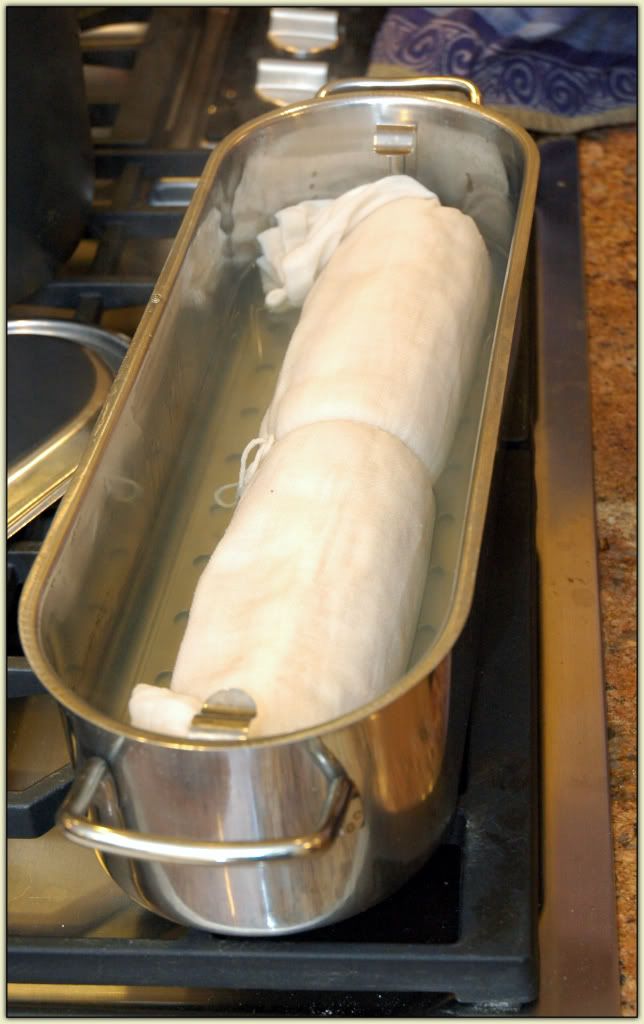
The Roly-Poly in its cloth, boiling happily away.
To serve, remove the pudding from the boiling water, untie and unroll the cloth, and turn out (seam-side down) onto a platter. Serve hot with custard sauce alongside.

Denny, the Not-So-Grouchy Cripple.

Stefan tastes a wine that was laid down during the Nixon administration.

Gravlax with Swedish knakkebröd (crispbread) and akvavit chasers. The silver implements belonged to Houston Steve’s great-great-grandmother.

Blini - yeast-raised buckwheat pancakes - with crême fraîche and three kinds of caviar (salmon, whitefish, and bowfin).
For those who crave a taste of a dessert so authentically British, even most Brits are afraid of it, try this:
Treacle Roly-Poly

Treacle Roly-Poly, ready to slice and serve with lashings of Custard Sauce.
Dough:
½ pound suet, finely grated
4 cups flour
¼ cup sugar
½ tsp salt
Ice water
Filling:
¼ cup treacle
¼ cup sugar
Juice and grated zest of ½ lemon
1 large knob fresh ginger (about 1½ inches long), peeled and grated
Mix the suet, flour, sugar, and salt in a large bowl. Work in 1-2 tbsp ice water. Continue gradually adding ice water until you have a stiff paste...this may take as much as a cup of water...and work it with your hands until it forms a ball. Turn it out onto a well-floured board. Cover with a damp cloth and let rest for five minutes.
Now, knead the dough 6-8 minutes, until it is shiny and elastic. Cover again, let rest again for five minutes, then knead for 1-2 minutes. Roll out the dough, making a rectangle about ¼ inch thick.
Combine the ingredients for the filling in a bowl; mix well. (Steve used a blend of Lyle’s Golden Syrup with a touch of molasses to approximate the flavor of real treacle, which is rather thin on the ground in our neighborhood). Spread the filling over the dough rectangle, leaving a one-inch border around the edges to allow for oozing. Moisten three of the edges of the dough with water; then starting with the fourth edge, roll up the pudding, sealing the edges as you go. Seal the final edge by pinching the dough together to form a seam.
Wrap the pudding-cylinder in a well-floured cloth. Tie securely at both ends and in the middle. Immerse the pudding in a pot of rapidly-boiling water (Steve used a fish poacher, in which the cylinder fit perfectly) and cook for 2½ hours, adding more boiling water as needed.

The Roly-Poly in its cloth, boiling happily away.
To serve, remove the pudding from the boiling water, untie and unroll the cloth, and turn out (seam-side down) onto a platter. Serve hot with custard sauce alongside.


















No comments:
Post a Comment